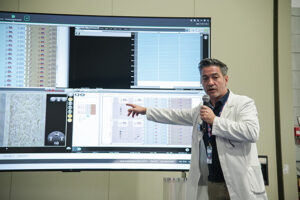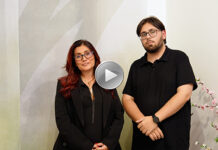Last 5 November in Milan, Acimga’s Italian Rotogravure Group organized a day of in-depth discussion, with important insights that highlighted a vibrant community called to face challenges to regain market share. The conference concluded with a visit to Poplast, a leading flexible packaging manufacturer, which chose to configure its two BOBST gravure presses with Extended Color Gamut

“Think, create, print in gravure: innovations, applications and sustainability”, with this title the Italian Rotogravure Group launched the fourth edition of Roto4All 2024, a day dedicated to gravure sector, with market data, technological updates, interesting research on the world of packaging and training with the intervention of some former students of ITS Angelo Rizzoli.
The introductory part by Enrico Barboglio and Daniele Barbui, director and president of Acimga respectively, highlighted, thanks to an analysis of bilateral trade flows (import-export) related to auxiliary machinery and equipment for gravure printing, a wide room for growth in the Italian market. At export level, Italy ranks second, behind China but ahead of Germany, while major importers include Uzbekistan (actually an indirect transit flow to Russia), India, Vietnam, Iran, and Indonesia.
The forecast data for world trade sales of gravure machines are positive and show a +4.7% in 2024 and the growth trend will be steady for the next 4 years with +5.6% in 2028.
The gravure market in ERA’s analysis: from artisanal system to industrial printing

Davide Garavaglia, as president of ERA, the European Rotogravure Association that will soon turn into GRA Global Rotogravure Association, gave an overview of the flexible packaging sector globally, divided in the different geographical areas and also taking into consideration the domestic demand of the different countries for both flexo and gravure presses. At application level, the main outlet markets analyzed are flexible packaging, but also decorative and cartonboard although to a lesser extent than packaging.
Garavaglia’s speech was deliberately provocative to stimulate the entire gravure supply chain to broaden its horizons with respect to a deep-rooted technology that, however, has not been able to innovate at the level of, for example, flexo, which has the advantage of greater flexibility in applications.
Although the flexo market is generally larger than the gravure market, the latter is well positioned in terms of market share in India and China, here local companies build presses. While gravure suffers at European level compared to flexo and digital but also in North America where flexo is the reference printing technology. From this analysis, Garavaglia made a call for unity and system-building in the gravure supply chain to elevate know-how from a craft level to an industrial level. The growth potential for the gravure industry is there, but the market needs solutions for short runs and consequently also for a substantial drop in costs.
ERA also analyzed the gravure prepress market, with a focus on cylinder engraving over the last 4 years from 2021 to 2024 with a sharply declining trend, and this despite the increase in flexible packaging printing volumes. “This figure is emblematic of the fact that other technologies such as flexo and digital have been able to innovate their process, building a much more industrialized system than gravure”, Garavaglia says. Certainly, gravure printing, with excellent quality results and consistent repeatability combined with substantial ease of use for the operator, has been sitting on its laurels, losing that motivational drive toward improving its process. “The time has come to create innovation not as individual players in the industry but as a supply chain to help the market develop more of an industrial process, because gravure is still too tied to craftsmanship and this is not enough anymore. Today fortunately we have all the tools to create a gravure system, which from materials to prepress and printing technologies, can meet market demands at competitive costs”, adds Garavaglia, who then points out that Italy is one of the countries where the quality of gravure printing is excellent, with high know-how but still too much linked to the craftsmanship of the single operator.

Pack Around 2024, research on the world of packaging
PackAround 2024, is the research on present and future investments in packaging, carried out in collaboration with Largo Consumo, and presented by Michela Pìbiri, Editor in Chief of PRINTlovers. The study analyzed the world of packaging as a whole, starting from the design stages, through development, material analysis and the choice of different printing and ennobling techniques, and ending with an in-depth look at product’s supply chain and sustainability. The research also discusses ecodesign in packaging design as well as the value that sustainability has as a sales vehicle for the product. The result is a varied and multifaceted overview, but one act is incontrovertible: the overall costs of fully adopting sustainable packaging are the main obstacle for brand owners.
Two panel discussions, between technology and education

In a round table discussion attended by Davide Rossello, BOBST, Fabrizio Imarisio, DEC – Dynamic Environmental Corporation, Andrea Caselli, Uteco and Fabio Gonzatto, Windmoeller & Hoelscher Group, the main changes involving the flexible packaging market and how technological innovations in gravure have provided answers to new needs were discussed. The packaging industry has changed significantly in recent years, today the search for customization and consumer tastes has greatly amplified, and in the print market this translates into shorter runs and more different subjects to print. Single-material packaging and paper-based solutions are definitely the trend of the moment, and production technologies must meet these demands, as through technological innovation cost increases can be offset. After all, with Industry 5.0 the focus is on sustainability and attention to energy consumption costs, new technologies must take this into account to lower emissions, consumption and give answers to printers who are starting to increasingly take TCO (total cost of ownership) into account when managing their work.

The second discussion focused on training, with the collaboration and contribution of ITS Angelo Rizzoli. Moderated by Raffaele Angelillo, the new Editor in Chief of Converting magazine to whom we wish a good job, four young former students were interviewed and they talked about their training experience that later culminated in a job within the industry.
ITS Rizzoli conceived the two-year Packaging Specialist training course four years ago now, as a response to a specific market need, because technical figures trained in packaging production are not available. The concept of collaboration between different players returns in this context as well, once again underscoring the importance of maintaining a direct channel between the world of training and the world of production.
A visit to Poplast
Open doors at POPLAST for the visit organized on November 6 to see and touch the validity and quality of gravure printing that in the Piacenza-based company, a leader in the production of flexible packaging, has been configured for printing in ECG Extended Color Gamut with great results also in terms of savings.
 Sales Manager Andrea Ghu has welcomed the guests and leaded the day, then leaving the floor to Carlo Callegari, CEO of Poplast together with Pierangelo Fantoni. Callegari retraced the company timeline, with all the most important milestones, starting in 2016 when the company had a turnover of €34 million. The path of technological and skills growth and a strategic acquisition have led the company to have a turnover of €105 million in 2023 with a 2024 that will close in line with last year. Today there are two production plants, one in the Piacenza area where the headquarters are located and one in the province of Pistoia where FM Plastic is based, which after the acquisition has now become a part of the Group.
Sales Manager Andrea Ghu has welcomed the guests and leaded the day, then leaving the floor to Carlo Callegari, CEO of Poplast together with Pierangelo Fantoni. Callegari retraced the company timeline, with all the most important milestones, starting in 2016 when the company had a turnover of €34 million. The path of technological and skills growth and a strategic acquisition have led the company to have a turnover of €105 million in 2023 with a 2024 that will close in line with last year. Today there are two production plants, one in the Piacenza area where the headquarters are located and one in the province of Pistoia where FM Plastic is based, which after the acquisition has now become a part of the Group.

Before the printing demo on the BOBST RS 6003 gravure press, Francesco Maria Costanzo, an advocate of the birth of the in-house prepress department and prepress manager at Poplast, described the path he was able to develop, thanks to the trust of the company management that gave him carte blanche to realize what seemed an impossible challenge, namely replicating in gravure the dynamics of digital printing. Today that dream, thanks in part to Costanzo’s passion and determination, has become a reality, and at Poplast, BOBST’s gravure press is configured for gravure printing with seven colors.

During the printing demo, 3 different subjects were reproduced on the same cylinder, to produce the packaging that Poplast will use next year to celebrate its 50th anniversary in the flexible packaging industry.
“As with all previous editions, with Roto4All 2024 we have confirmation of how united and collaborative the gravure community is”, says Enrico Barboglio, Director of ACIMGA. “One concept undoubtedly emerges from the event that stands out above the others: partnership. Also, after this open house we bring home a change of perspective that is the key to the creation of a gravure system of the highest level: no longer supplier-customer relationships, but relationships between technological partners, from which all the players involved drive benefits. Even more, this perspective should be extended to the entire printing sector that the association represents, and which finds in Print4All 2025 the place where this new relational mode between players finds concreteness”.























